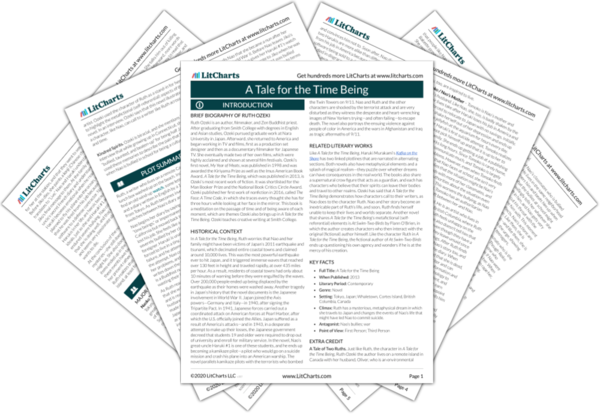Welcome to the LitCharts study guide on Ruth Ozeki's A Tale for the Time Being. Created by the original team behind SparkNotes, LitCharts are the world's best literature guides.
A Tale for the Time Being: Introduction
A Tale for the Time Being: Plot Summary
A Tale for the Time Being: Detailed Summary & Analysis
A Tale for the Time Being: Themes
A Tale for the Time Being: Quotes
A Tale for the Time Being: Characters
A Tale for the Time Being: Terms
A Tale for the Time Being: Symbols
A Tale for the Time Being: Theme Wheel
Brief Biography of Ruth Ozeki

Historical Context of A Tale for the Time Being
Other Books Related to A Tale for the Time Being
- Full Title: A Tale for the Time Being
- When Published: 2013
- Literary Period: Contemporary
- Genre: Novel
- Setting: Tokyo, Japan; Whaletown, Cortes Island, British Columbia, Canada
- Climax: Ruth has a mysterious, metaphysical dream in which she travels to Japan and changes the events of Nao’s life that might have led Nao to commit suicide.
- Antagonist: Nao’s bullies; war
- Point of View: First Person; Third Person
Extra Credit for A Tale for the Time Being
A Tale of Two Ruths. Just like Ruth, the character in A Tale for the Time Being, Ruth Ozeki the author lives on a remote island in Canada with her husband, Oliver, who is an environmental artist. Ozeki used the character of Ruth as a stand-in for herself to highlight the metafictional (self-referential) aspects of the novel. In an interview, Ozeki says that this novel illustrates how a character, like Nao, can call to a writer like Ruth across space and time.
Kindred Spirits. Ozeki is biracial, and she mentions in an interview that while growing up in Connecticut, she was “bullied, taunted, and beaten-up” for being half Japanese. She used these memories to describe the pain that Nao experiences when Nao is bullied in school for being a cultural outsider.







